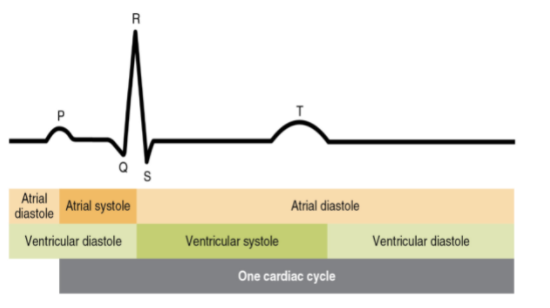
Depolarisation of atria is represented by
A) P-wave
B) Q-wave
C) T-wave
D) QRS complex
Answer
502.2k+ views
Hint: This is the first wave that is obtained in an electrocardiogram (ECG). It occurs due to the electrical excitation of the atria. This is called depolarization of the atria. The depolarization of atria results in the contraction of both the atria. This wave is obtained just before the QRS wave.
Complete answer:
To answer this question we should know about the waves obtained in an ECG. The P- wave is the first wave that is obtained in an ECG and it represents the depolarization of atria. The electrical excitation of atria is called depolarization of atria and it causes contraction of atria.
In an ECG, the first downward deflection is called Q-wave. It occurs just after the P-wave. It shows the initial phase of the QRS wave. The QRS wave obtained in an ECG shows depolarization of ventricles and it results in contraction of both the ventricles. The ECG helps in the calculation of heart rate. This is done by counting the number of QRS complexes in a given time period.
The repolarisation of ventricles is represented by the T-wave. Repolarisation means relaxation of ventricles. It is the last wave of an ECG. The waves obtained in one cardiac cycle is

Thus the answer is P-wave as this wave represents the depolarization of atria. After the depolarization of atria, depolarization of ventricles occurs which is shown by the QRS wave.
Therefore the correct answer is option ‘A’.
Note: The Electrocardiograph is a machine that is used to study the movement of the heart electrically during each cardiac cycle. The graph obtained from the electrocardiograph is called an electrocardiogram (ECG). A standard ECG consists of 12 leads. Six leads are placed on the limbs of the person and are called limb leads. The other six leads are placed on the precordial and are called precordial leads. It helps in the diagnosis of various diseases of the heart.
Complete answer:
To answer this question we should know about the waves obtained in an ECG. The P- wave is the first wave that is obtained in an ECG and it represents the depolarization of atria. The electrical excitation of atria is called depolarization of atria and it causes contraction of atria.
In an ECG, the first downward deflection is called Q-wave. It occurs just after the P-wave. It shows the initial phase of the QRS wave. The QRS wave obtained in an ECG shows depolarization of ventricles and it results in contraction of both the ventricles. The ECG helps in the calculation of heart rate. This is done by counting the number of QRS complexes in a given time period.
The repolarisation of ventricles is represented by the T-wave. Repolarisation means relaxation of ventricles. It is the last wave of an ECG. The waves obtained in one cardiac cycle is

Thus the answer is P-wave as this wave represents the depolarization of atria. After the depolarization of atria, depolarization of ventricles occurs which is shown by the QRS wave.
Therefore the correct answer is option ‘A’.
Note: The Electrocardiograph is a machine that is used to study the movement of the heart electrically during each cardiac cycle. The graph obtained from the electrocardiograph is called an electrocardiogram (ECG). A standard ECG consists of 12 leads. Six leads are placed on the limbs of the person and are called limb leads. The other six leads are placed on the precordial and are called precordial leads. It helps in the diagnosis of various diseases of the heart.
Recently Updated Pages
Master Class 12 English: Engaging Questions & Answers for Success

Master Class 12 Economics: Engaging Questions & Answers for Success

Master Class 12 Social Science: Engaging Questions & Answers for Success

Master Class 12 Maths: Engaging Questions & Answers for Success

Master Class 12 Chemistry: Engaging Questions & Answers for Success

Master Class 12 Business Studies: Engaging Questions & Answers for Success

Trending doubts
What are the major means of transport Explain each class 12 social science CBSE

Which are the Top 10 Largest Countries of the World?

Draw a labelled sketch of the human eye class 12 physics CBSE

Explain sex determination in humans with line diag class 12 biology CBSE

The pH of the pancreatic juice is A 64 B 86 C 120 D class 12 biology CBSE

Explain sex determination in humans with the help of class 12 biology CBSE




